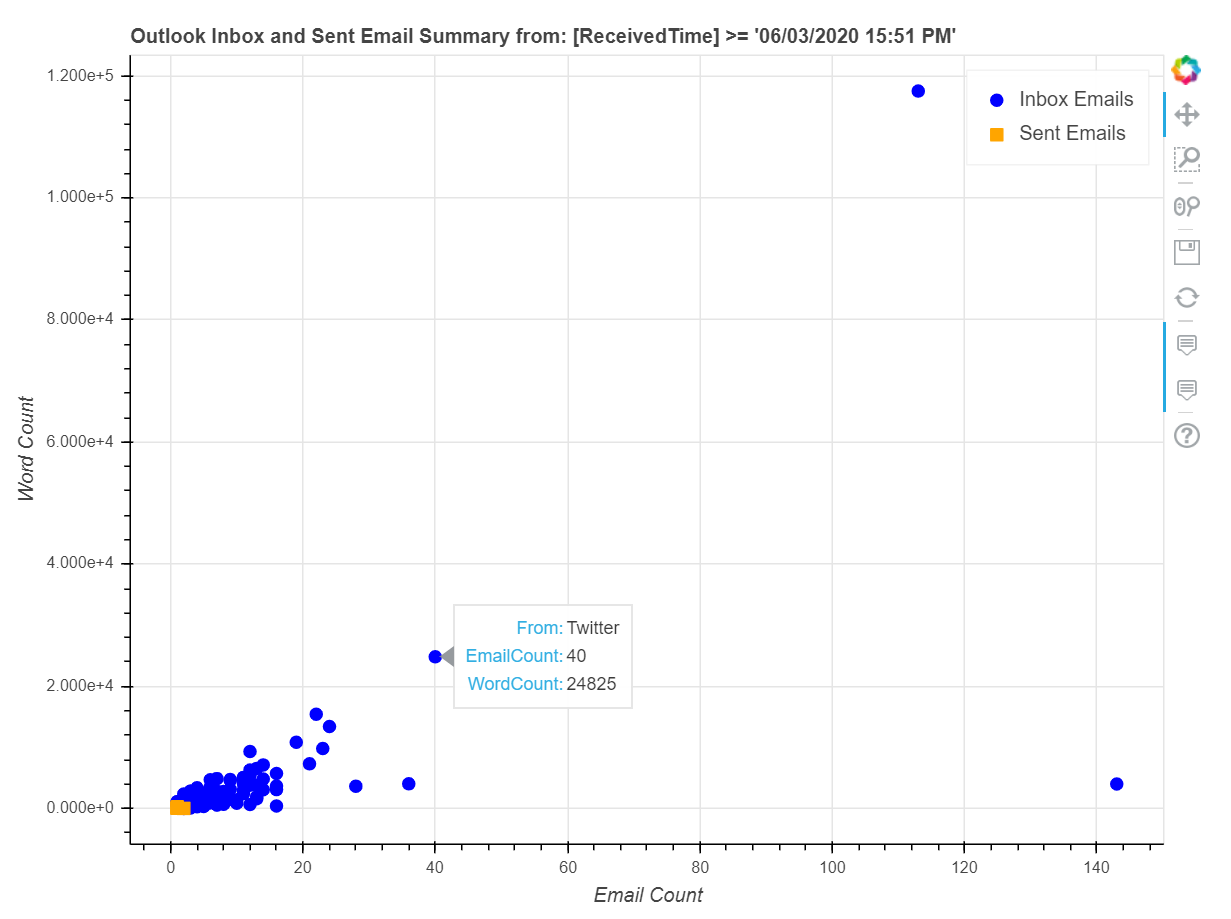Notebook creates a summary of the # of emails sent and received from Microsoft Outlook within a specific period defined - it uses the Bokeh to create the interactive visualization.

# Import all the modules required
import pandas as pd
from win32com.client import Dispatch
import datetime as dt
from bokeh.plotting import figure, output_file, show
from bokeh.models import ColumnDataSource
from bokeh.models.tools import HoverTool
# Calculate specific date/time
last24Hours = dt.datetime.now() - dt.timedelta(hours = 24)
lastWeek = dt.datetime.now() - dt.timedelta(days = 7)
lastMonth = dt.datetime.now() - dt.timedelta(days = 30)
lastTwoMonths = dt.datetime.now() - dt.timedelta(days = 60)
# Convert the text into a format that Outlook understands.
last24HourMessages = "[ReceivedTime] >= '" +last24Hours.strftime('%m/%d/%Y %H:%M %p')+"'"
lastWeek = "[ReceivedTime] >= '" +lastWeek.strftime('%m/%d/%Y %H:%M %p')+"'"
lastMonth = "[ReceivedTime] >= '" +lastMonth.strftime('%m/%d/%Y %H:%M %p')+"'"
lastTwoMonths = "[ReceivedTime] >= '" +lastTwoMonths.strftime('%m/%d/%Y %H:%M %p')+"'"
fromThisMorning = "[ReceivedTime] >= '" +dt.datetime.now().strftime('%m/%d/%Y ')+"7:00 AM'"
# Test print out of the output
print(lastMonth)
[ReceivedTime] >= '06/03/2020 15:51 PM'
# Use this to change the filter based on the time restriction filters above.
# This will be used in the code below as the main filter for dates when the code runs
emailfilter = lastMonth
## Connect to Inbox
outlook = Dispatch("Outlook.Application").GetNamespace("MAPI")
# "6" refers to the index of a folder. 6 is the inbox
inbox = outlook.GetDefaultFolder('6')
sent = outlook.GetDefaultFolder('5')
# all inbox in the lastHourDateTime (above)
inbox_emails = inbox.Items.restrict(emailfilter)
sent_emails = sent.Items.restrict(emailfilter)
inbox_from = []
inbox_mail_wc = []
sent_to = []
sent_mail_wc = []
## iterate through list of emails in inbox, and filter based on message class 43 = email.
for msg in inbox_emails:
if msg.Class == 43:
# cast the object as a string
inbox_from.append(str(msg.Sender))
inbox_mail_wc.append(len(str(msg.Body).split()))
inbox_df = pd.DataFrame(list(zip(inbox_from, inbox_mail_wc)))
inbox_df.columns = ['Inbox_from','Inbox_wc']
## Sent email section
for msg in sent_emails:
if msg.Class == 43:
# cast the object as a string
sent_to.append(str(msg.To))
sent_mail_wc.append(len(str(msg.Body).split()))
sent_df = pd.DataFrame(list(zip(sent_to, sent_mail_wc)))
sent_df.columns = ['Sent_to','Sent_wc']
# This code uses aggregates and produces new column names with count and sum, then sorting the values based on nlargest
inbox_summary = inbox_df.groupby(['Inbox_from'])['Inbox_wc'].agg(InboxEmailCount=('Inbox_from','count'), InboxWordCount=('Inbox_wc','sum')).sort_values(['InboxEmailCount','InboxWordCount'],ascending=False).nlargest(200,'InboxEmailCount')
sent_summary = sent_df.groupby(['Sent_to'])['Sent_wc'].agg(SentEmailCount=('Sent_to','count'), SentWordCount=('Sent_wc','sum')).sort_values(['SentEmailCount','SentWordCount'],ascending=False).nlargest(200,'SentEmailCount')
inboxsource = ColumnDataSource(inbox_summary)
sentsource = ColumnDataSource(sent_summary)
# Create an interactive HTML report
output_file('OutputReport.html')
p = figure(plot_width=800, plot_height=600)
r1 = p.circle(x='InboxEmailCount', y='InboxWordCount',
source=inboxsource,
size=8, color='blue', legend_label='Inbox Emails')
r2 = p.square(x='SentEmailCount', y='SentWordCount',
source=sentsource,
size=8, color='orange', legend_label='Sent Emails')
p.title.text = 'Outlook Inbox and Sent Email Summary from: ' + emailfilter
p.xaxis.axis_label = 'Email Count'
p.yaxis.axis_label = 'Word Count'
p.add_tools(HoverTool(renderers=[r1], tooltips=[
('From', '@Inbox_from'),
('EmailCount', '@InboxEmailCount'),
('WordCount', '@InboxWordCount')
]))
p.add_tools(HoverTool(renderers=[r2], tooltips=[
('To', '@Sent_to'),
('EmailCount', '@SentEmailCount'),
('WordCount', '@SentWordCount')
]))
show(p)